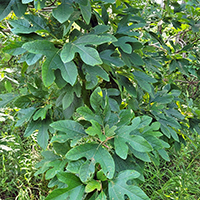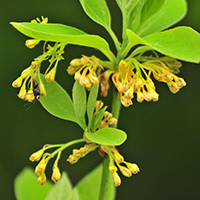What sassafras looks like
Size and shape
- Reaches up to 20 metres tall.
- Trunk grows up to 50 centimetres in diameter.
Leaves
- Green leaves that can have no lobes or 2 to 3 lobes (10 to 15 centimetres).
- Occur in all shapes on the same tree.
- Have blunted tips and smooth margins.
- Turn yellow to red in fall.
Bark
- Dark brown and grooved with corky ridges.
Flowers
- Small greenish-yellow flowers grow in loose clusters before leaves appear.
Fruit
- Dark blue berry-like fruits grow in clusters in red cups on a red stalk (10 to 15 centimetres).
Where sassafras is found
Sassafras is not common in Ontario. It is found in the Carolinian Zone, the southern-most portion of Ontario, as far north as Toronto. Where it occurs, sassafras often forms colonies.
What you need to know to grow sassafras
- Moisture: grows best in well-drained soils.
- Soil: grows best in loamy and sandy soils.
- Shade: grows best in a mix of full sun and part shade and intolerant of deep shade.
- Caution: sassafras trees have thin trunks that are susceptible to ice and wind damage.
Benefits and uses of sassafras
Wildlife benefits
Sassafras fruit is a food source to many species, including:
- foxes
- wild turkeys
- squirrels
Commercial uses
Sassafras wood is a hardwood commonly used to produce:
- lumber
- fence posts
- boats
- furniture
Fun facts about sassafras
- Sassafras trees rarely live longer than 30 years.
- Sassafras roots were historically used to flavour root beer, but this flavouring is now known to cause cancer and is no longer used.
- Crushed or bruised sassafras leaves have a spicy smell.
Updated: January 10, 2024
Published: July 18, 2014




